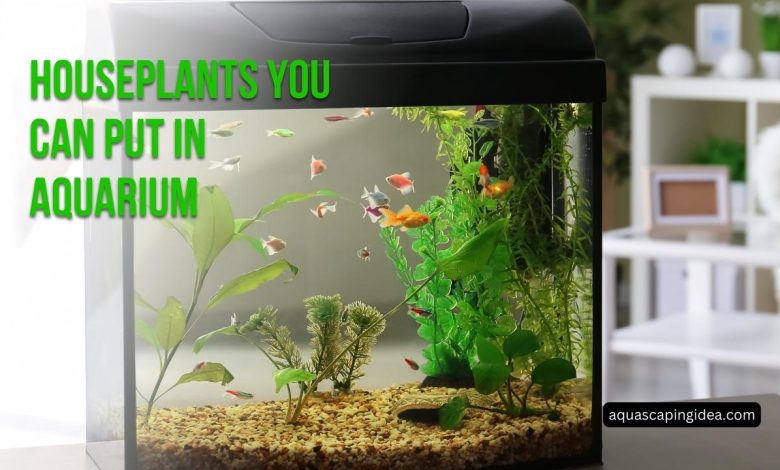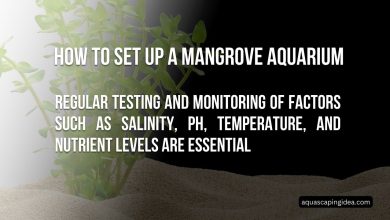Houseplants You Can Put in Aquarium

Adding live Houseplants to your aquarium provides many benefits for both you and your fish. The right species can oxygenate the water, absorb harmful chemicals, provide shade and shelter, and bring a slice of nature into your home. However, not all houseplants are suitable for submerged life. This guide will explore the best varieties to consider and how to care for them in an aquarium environment.
Top Houseplants Suitable for Inside Aquariums
If you want to integrate houseplants directly into your tank, focus on resilient varieties that tolerate wet feet. Here are prime options:
Floating Plants – Effortless Oxygenators
Floating at the water’s surface, these plants are the easiest way to add greenery and improve oxygen levels. Their roots hang freely down into the water, so they draw in carbon dioxide and release oxygen continuously. Being able to move around, they can find the best light levels too.
Duckweed
Tiny, bright green leaves make duckweed a great choice for small fish and fry that need cover from lights or larger tank inhabitants. It grows rapidly to form a lush blanket at the surface. Remove handfuls regularly to stop it taking over the whole area.
Frogbit
Larger round leaves with trailing roots make frogbit stand out. Its minimal nutrient needs mean it thrives in most setups. The long dangling roots provide shelter and surface area for beneficial bacteria. Avoid completely shading the tank, as other plants need light.
Water Lettuce
This floating plant offers unique textured leaves that fish love to swim through. The feathery roots also give surface coverage. Being more sensitive than other floaters, water lettuce needs good light and nutrients to flourish. It’s worth the care for the cascading effect it gives.
Salvinia
A versatile option, salvinia has small round leaves with a trailing root system. It grows speedily to cover surface areas and create dappled light effects. Trim off excess growth regularly and distribute plants to prevent clumping. The dense mat it forms provides safe breeding spots for shy fish species.
Submerged Plants – Absorbers and Oxygenators
Growing fully underwater, these plants don’t require as much care and maintenance as floaters. Submerged varieties release oxygen into the water through their leaves and establish extensive root systems that are beneficial for aquarium filtration.
Anubias
With thick waxy leaves above a sturdy rhizome, anubias are almost indestructible submerged plants. They grow slowly but need minimal care, thriving even in low light tanks. Just attach their rhizome to wood or rocks, avoiding burying it. Large-leaved types like Anubias barteri offer shady hiding spots.
Java Fern
Another hardy option, java fern attaches to decor instead of requiring planting. Its long-lasting dark green leaves provide shelter and surface area for biofilm growth. Undemanding water parameters allow java fern to work in most setups. Varieties like narrow leaf and windelov fern have different textures.
Amazon Swordplant
A classic aquarium plant, amazon swords become an impressive centerpiece with their long leaves and purple under-sides. Root tabs help nourish their extensive roots systems. Give them plenty of space as they can grow over 12 inches tall and wide. Prune old leaves to keep their appearance lush.
Cryptocorynes
For lush foliage at mid-level heights, try cryptocoryne varieties like wendtii and retrospiralis. They grow slowly from rhizomes and thrive in softened acidic water. Their reddish brown leaves bring color and interest while providing cover. Ensure sufficient iron and traces to keep cryptocorynes looking their best.
Emergent Plants – Naturally Beautiful
Emergent or marginal plants are rooted in the substrate underwater, while their stems and leaves extend above the waterline. Allowing these to grow out of your aquarium creates a striking semi-aquatic effect.
Pothos
With its trailing vine-like stems and heart-shaped leaves, golden pothos is a popular choice. It can grow directly out of a HOB filter or hang its tendrils down into the water. Keep its leaves above water and provide bright indirect light. Trim back long vines to create a bushier look.
Philodendrons
Similar to pothos, philodendron varieties like Brasil and Micans offer unique leaf textures and patterns above the water. Avoid direct sunlight to prevent leaves burning. Let its vines spread across driftwood emerging from the tank for a jungle effect.
Lucky Bamboo
For a touch of zen, lucky bamboo’s straight green stems look striking grown emergent. Select hardy varieties like curly bamboo. Ensure leaves remain above water and provide bright light to prevent rotting. Change water regularly and remove any yellowing stems.
Peace Lily
With pretty white flowers above water and trailing roots below, peace lily is a dual purpose plant. It removes toxins in the water while creating a focal point above. Give it very bright indirect light to encourage flowering. Prune off any saturated or rotten leaves to maintain its health.
Benefits of Aquarium Plants
Alongside being visually appealing, the right plants bring many scientific advantages to your aquarium’s ecosystem.
Oxygenation
Photosynthesizing plants continuously release oxygen into the water through their leaves and roots. This oxygenation counteracts the carbon dioxide produced by breathing fish and bacteria. Heavily planted tanks need less air stone aeration.
Toxin Removal
Aquatic plants act as living filters by absorbing ammonia, nitrates, nitrites, and phosphates from fish waste and decaying matter. Floating and emergent varieties are especially efficient at removing nitrogen compounds.
Habitats and Shelter
Fish and invertebrates appreciate plant coverage that replicates their natural environments and provides security. Breeding fish rely on dense floating growth to hide fry. Slow bottom rooted plants offer caves for shy species.
Stabilizing Water Parameters
Along with filtering toxins, aquatic plants help stabilize pH levels and water hardness. Photosynthesis softens water by removing calcium and carbonate ions. The organic matter released also creates a natural buffer against parameter swings.
Natural Beauty
Greenery softens the artificial look of glass tanks and decorations, creating a balanced ecosystem. Texture, color, and shape from mixed plant species bring an aesthetically pleasing naturalistic habitat.
Considerations for Keeping Aquarium Plants
While plants offer many advantages, keeping them beautiful and thriving takes some specialized care and maintenance.
Lighting Requirements
Photosynthetic plants depend on light to grow. Floaters and emergent varieties need very bright indirect natural daylight or full spectrum aquarium lighting. Submerged plants grow under more moderate lighting, with some thriving in low tech setups.
Nutrient Needs
Depending on their growth rate, plants consume substantial amounts of micronutrients, traces, carbon, potassium, nitrogen, and phosphate. These are provided through aquarium substrates and the water itself in planted tanks. Slow growing plants are less demanding.
Planting and Attachment
Bareroot plants should be planted carefully into gravel or substrate, while rhizome plants need attaching to hardscape decor. Improper planting damages roots and causes deterioration or floating up. Take care to not bury rhizomes that need water flow across them.
Quarantining Additions
Before introducing new plants from outdoor waterways or other tanks, quarantine and disinfect them to prevent transmitting diseases and pests to aquarium inhabitants. Use diluted bleach or specialty plant disinfectants to eliminate snails and pathogens.
Managing Growth
Fast growing stem plants and floaters can quickly overtake a tank, preventing light from reaching other plants and fish. Routinely trim and thin them to balance your aquascape. Remove dying plant matter to avoid pollution from decay.
Integrating Houseplants into Aquariums
Here is a table summarizing the step-by-step process for integrating houseplants into aquariums:
| Step | Description |
|---|---|
| Select Plant | Choose houseplant species that tolerate moist soil and high humidity, like pothos, philodendrons, anubias, java fern, etc. Avoid poisonous varieties. |
| Rinse Roots | Carefully wash roots under tap water to remove loose soil and prevent cloudiness. Trim any damaged sections. |
| Plant in Tank | Plant roots firmly in substrate, with the lower stem submerged but leaves rising above the waterline. The plant should stay stationary once anchored. |
| Acclimate Plant | Let the newly added plant adjust gradually to the humid, bright environment to prevent shock. Observe closely for signs of stress. |
| Provide Support | Add support sticks, trellises, or frames as needed so foliage doesn’t dip underwater and rot. But houseplant roots should remain submerged. |
Conclusion
Adding any of these popular hardy houseplants can bring a new dimension to your aquarium, benefiting both you and your fish. Take some time to research which varieties best suit your setup in terms of space, lighting, maintenance needs, and aesthetics. Balance floating, submerged, and emergent plants to create a visually stunning aquatic garden. With the right plants, your aquarium will become a thriving indoor ecosystem.
Frequently Asked Questions
What lighting do I need for aquarium plants?
Most aquarium plants need moderate to high intensity lighting for at least 8-10 hours daily. LED full spectrum plant lights or daylight T5 fluorescent lamps work well. Floaters and emergent plants need very bright indirect natural light.
Do I need to supplement CO2 for plant growth?
Adding carbon dioxide allows plants to photosynthesize faster, but is not essential in low tech setups. With sufficient light and nutrients, many hardy varieties will grow without CO2 supplementation. It becomes more important in densely planted tanks.
What fertilization do aquarium plants need?
While fish waste provides some nutrients, this is rarely enough for thriving plant growth. Use root tabs for heavy root feeders and add liquid fertilizers to the water weekly that contain macronutrients, micronutrients, and trace elements specific to aquarium plants.
How often should I trim and thin aquarium plants?
Fast growers like stem plants, floaters, and emergent vines need thinning and trimming every 1-2 weeks to control rapid growth. Slower growers may only need occasional shaping. Remove yellowing leaves at the base. Replant healthy trimmings to propagate plants.
How do I avoid introducing pests with new plants?
Always quarantine new plants in a separate tank for 1-2 weeks before adding them to your display aquarium. Use diluted bleach or other disinfectants to kill any snails, algae, parasites or pathogens. Thoroughly rinse plants before adding them to the main aquarium.
How do I stop my pothos leaves rotting underwater?
If pothos foliage stays submerged too long, it will yellow, wilt, and rot. Add support sticks and pruning to keep leaves and stems above the tank waterline. Just the roots should be underwater.
Which houseplants filter aquarium water?
Some top natural filters include pothos, philodendrons, bamboo, and bromeliads. As the plants grow, they absorb nitrogen compounds and help clean the water to support fish and amphibians.
Should I add fertilizer for aquarium houseplants?
While fish waste provides some nutrients, you’ll likely need plant-specific liquid fertilizer to fuel growth without negatively impacting water quality. Dose cautiously and monitor how much the plants use to guide your schedule.
Can I grow houseplants fully submerged underwater?
A few specialized aquatic plants like anubias barteri or cryptocorynes may survive fully submerged. But most common houseplants require aerial leaves that rise above the tank water for sufficient gas exchange to prevent rot.




